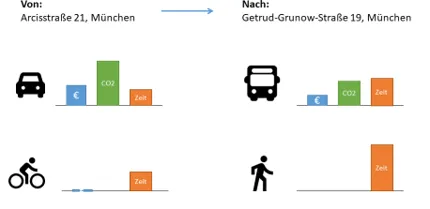M Cube | Smart Advisor for Sustainable Integrated Mobility (SASIM) - A Full Cost Perspective on Urban Traffic
Project Completed - Contact: Lennart Adenaw, M.Sc.

Project goals
The project will develop a full cost calculator that processes the internal (individual) and external (societal) costs of different forms of mobility in context, allowing them to be considered in an integrated manner for the first time in a single tool. This basis will enable appropriate planning and management of mobility to promote the use of sustainable mobility options. Specifically, the full cost calculator will be applicable as follows:
- The full costs of different means of transport are presented comprehensively and transparently in order to evaluate mobility options with regard to relevant sustainability criteria to be defined.
- Citizens can inform themselves about the full costs of different forms of mobility with the help of an app or an online tool. Raising awareness and cost transparency could in turn lead to behavioral changes.
- Based on the costs of different mobility options, scenarios for a holistic, dynamic pricing system will be developed. Pricing incentives, which may be embedded in a mobility-as-a-service system using maximum available budgets in the future, allow influencing mobility behavior across different transport modes. Different mobility carriers design different cost structures, which are also passed on to customers differently. A uniform pricing, booking and payment system using a mobility budget with so-called mobility coins provides transparency and facilitates access to the system for customers.
- In addition, further strategic application perspectives for mobility planning are conceivable. Different perspectives are to be elaborated and the results made politically usable.
Contribution of the project to the implementation of the M Cube overall strategy
By comprehensively considering social, economic and ecological factors, the full cost calculator enables both an influence on the individual decisions of users and a better planning and marketing of mobility options by decision-makers. Mobility behavior can be managed to meet the M Cube missions (quality of time, space, and air). The project allows for a scientific assessment of the interactions between user preferences, transportation strategies, and traffic patterns. The focus on dynamic pricing mechanisms and mobility-as-a-service addresses key trends in mobility, such as digitalization, intermodality and new mobility services.
Approach
Basic research
Research of comparable tools; review of available data and calculation methods; preparation of basic principles and framework conditions for a dynamic pricing system.
Conception
Definition of system boundaries and assumptions for the analysis; identification of suitable calculation models; development of criteria for the sustainability assessment of means of transport and implementation in the form of a monetary control system; identification of target groups and use cases.
Implementation
Data collection and processing; development of an app or online tool; feeding interim results into political processes; operation and updating
Evaluation
Investigation of realized effects on mobility behavior through information and awareness raising; simulation of effects of pricing strategies on traffic patterns; assessment of social, legal
and social issues
Application perspectives
Identification of potential uses for strategic planning; development of scenarios for a dynamic pricing system for marketing mobility options, e.g. using mobility coin budgets